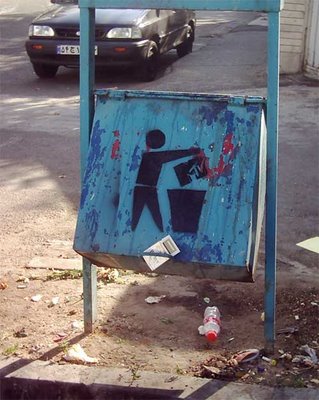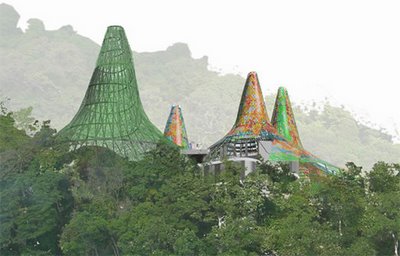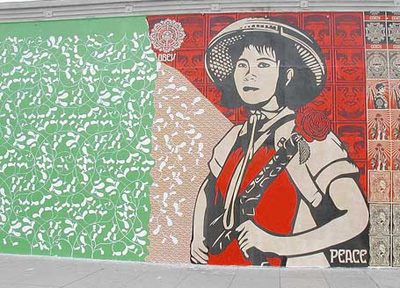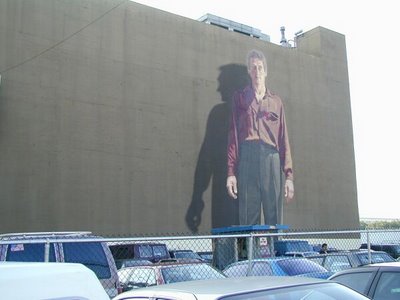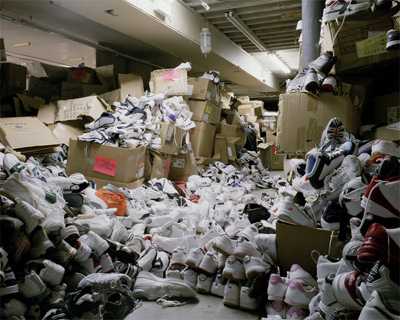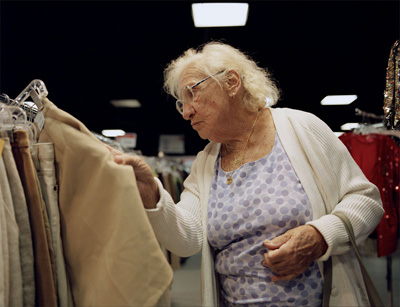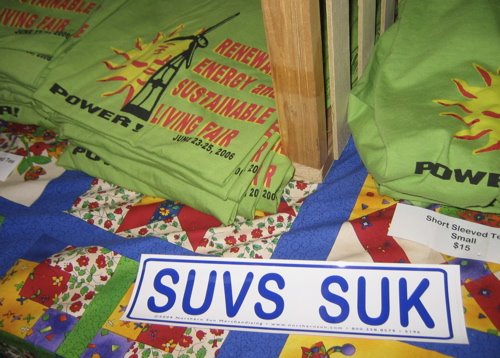
As the keynote speaker at last weekend's Renewable Energy & Sustainable Living Fair, author and new urbanist thinker James Howard Kunstler sounded the alarm that things can't go on as they always have: supplies of oil and natural gas simply can't sustain the interstate highway system, the country's isolated suburban pods and chain stores, and an urban planning mindset that puts the car front and center, leaving walkability and shared community largely out of the picture. We must "make other arrangements," he says. As a companion to the interview Nick Vander Puy and I did with Kunstler that's now up at Worldchanging (archived here), here's an adapted version of his keynote at the fair.
…Biodiesel is cool and ethanol is cool and switchgrass is cool and all the alternative fuels are very cool. We have to talk about that a lot, and it’s going to have a great deal of meaning for the future of this civilization. But we cannot just talk about running the car. Because the truth of the matter is that no combination of alternative fuels that we know about or even have dreamed about will allow us to continue running the interstate highway system, Walt Disney World, and Wal-Mart. Or even a substantial fraction of that…
…Dick Cheney made that interesting remark, that the “American way of life is non-negotiable.” You can understand that a traumatized nation [after 9/11] would need some reassurance, so Dick Cheney said, “Our way of life is non-negotiable.” It’s a grandiose statement, obviously, but the trouble is that it does truly reflect the thinking of most of the American public. You know, the real trouble is that’s a statement that does not comport with reality, because when you don’t negotiate the circumstances the world sends to you, you automatically get assigned a new negotiating partner. And it is called reality. And it won’t negotiate for you: it will tell you what you have to do whether you like it or not.
One of the symptoms of the low grade of discussion we’re having in this culture—maybe there’s some virus going around that’s making everyone in New York and Washington really stupid—the common thread that’s been going around is that American life, i.e. suburbia, is OK because people like it. Now, what kind of thinking is that? The companion idea is that it’s OK because people choose it. That’s the reasoning that comes from David Brooks at The New York Times and Joel Kotkin, the urban consultant, and Peter Huber of Forbes magazine and now Bob Bruegmann from the University of Illinois, whose new book Sprawl says, essentially, “It’s great because people choose it.”
Dick Cheney said, “Our way of life is non-negotiable.” It’s a grandiose statement, obviously, but the trouble is that’s a statement that does not comport with reality, because when you don’t negotiate the circumstances the world sends to you, you automatically get assigned a new negotiating partner.
But here’s the deal: it’s coming off the menu. Inform the waiters. Somebody go back and tell the kitchen: “86 the suburbia.” Not because I’m a mean person but because we’re just not going to be able to do it anymore. In an energy-scarce society, we’re not going to be able to run all that easy motoring and the 12,000-mile merchandise supply lines to far, far away, and the warehouse on wheels and all the other furnishings and accessories of the driving utopia.
So we’re going to have to make other arrangements. And there are tremendous impediments to thinking about making other arrangements. And one of them is what I’ve been calling for the last year the “Jiminy Cricket Syndrome.” It’s the idea that when you wish upon a star, your dreams come true. And the American public has been conditioned for about 60 years to believe that. From being incessantly bombarded with television advertising and Spielberg movies and Disney movies that we believe, you know, just wish for it and you can have it. You can be number one; just dream the dream, wish the wish.
It’s important for young people, for children, to believe in things. And it’s important for adults to tell children, when you wish upon a start dreams come true, because children are making that difficult journey from enchantment to harsh reality. And they need a little lubrication of the brain, so we tell them things like that. The trouble is when all the adults in your society continue to believe that. That’s where we’re at. The companion to that idea actually comes from America’s newest big religion, which is not Pentecostal Christianity, by the way. It’s the worship of unearned riches. And the holy shrine to it is Las Vegas.
I don’t see any of the evangelicals complaining about Las Vegas. Do you hear Pat Robertson inveighing against Las Vegas? I don’t think so. Have you noticed the recent advertising about Las Vegas? It’s “What goes on here, stays here.” And that’s ok with everybody. What do you think goes on in Las Vegas? I’ll tell you what goes on in Las Vegas. People hire prostitutes and they piss away their children’s college tuition. And that’s OK with us, and it’s OK with the evangelicals. I’m not a professional crusader against gambling, but this is actually very bad behavior and it’s leading to very bad thinking, and we’ve got to stop it. Probably it’s going to stop itself. Las Vegas is one of those places that is not going to function very well in an energy-scarce society. In fact, I think you can state categorically that the excitement will be over. Unless you’re a tarantula. Then you’ll be able to roam all 30 floors of Steve Wynn’s last hotel.
There are tremendous impediments to thinking about making other arrangements. And one of them is what I call the “Jiminy Cricket Syndrome.” It’s the idea that when you wish upon a star, your dreams come true. The companion to that idea actually comes from America’s newest big religion, which is not Pentecostal Christianity, by the way. It’s the worship of unearned riches.
Getting back to the fact that these are very, very dangerous ideas, that when you wish upon a star your dreams come true and that it’s possible to get something from nothing. That’s what the worship of unearned riches is all about—the idea that it’s possible to get something for nothing. That’s what the whole lottery mania is about. We’ve got to become a different kind of country.
There’s another major delusion, and I saw it illustrated in my trip to Google headquarters. Google is the highest level now of hi-tech computer-corporate enterprise. I went there last June; I was invited to give a talk. It’s in an office park in this suburban wasteland of illegible crap in Silicon Valley. Inside—it’s a normal, by today’s standards, office building—the whole place is tricked out like a kindergarten. They’ve got the foosball games and the knock hockey and the pool tables and the computer game consoles and the Lucite snackbox station every 11 feet (because you can never be more than 11 steps away from a sugary snack: the yogurt pretzels and the yogurt raisins and the gummi fish and the malted milk balls). The whole place is like the greatest daycare center in the world. And I’m thinking, wow, I didn’t know corporate America was this infantile.
So then the Google employees come in, and by “employees” I mean high-level brass, you know, upper echelon executives who are now all millionaires because they got on board 7, 8 years ago when it was a startup and they got stock options. They came in, the high-tech engineers and executives, and they’re dressed like skateboard rats. They’re wearing sideways hats, their asscracks showing, and it’s like they just got released from jail, because they’ve got no sneaker laces. And I’m thinking, this is corporate America? A bunch of guys with sideways hats?
So I gave my spiel about energy, and at the time I was trying to give an earnest talk about the global oil predicament and natural-gas predicament--and, by the way, I’m not doing that now because I assume many of you have heard it and don’t need to hear it again. So, after my spiel, we did questions. And the Googleites got up, and they didn’t have any questions, they just had comments, and it was all the same comment. Which was: “Like, dude, we’ve got technology,” with subtext “You’re an asshole.” It informed me about something that was interesting, which was that at the highest level of corporate enterprise in America, they don’t understand the difference between technology and energy. Because they’re not the same thing. You can’t just substitute one for the other. The airplane that I’ll be on later to Detroit, it’s not going to run on hard drives and ground up USB ports and other plastic-metal crap. You’re either going to put liquid hydrocarbon fuels in there or it’s not going to run.
This is what I think you’re seeing: you’ve got young people who’ve been extraordinarily personally successful at making money in technology by moving pixels around a screen with a mouse, so they’ve developed a kind of grandiose idea of what technology’s all about. And it’s not going to be about that. We’ve got a lot of questions we’re going to be facing with technology. The technology with this energy fair is very impressive and I’m sure we’re going to running an awful lot of it, but I’m sure many of you have considered how are we going to manufacture more of it after a certain point, when we’re starting to have trouble with energy and natural gas. Because what we’re seeing also is a kind of piggyback thinking: we’re piggybacking our assumptions and a lot of our hopes and expectations on what we know now.
In the last few months, a lot of people have been talking about Cuba. “Well, look at Cuba. Cuba lost its energy subsidy, and overnight they went through this transformation.” And it’s true that they did a heroic job of facing the problem and overcoming, and they’re continuing to do that. But we have to remember that Cuba accomplished that against that background of a world that’s still substantially peaceful and intact and full of abundant energy, still. That’s one of the things we have to bear in mind. It’s going to be quite a different story when we have to make our adjustments against a backdrop of a world that’s not necessarily peaceful, in which energy supplies will be disrupted, and in which there’s probably going to be a lot of turbulence and turmoil and a certain amount of hardship. It’ll be a different story.
Suburbia represents entropy made visible. From a purely economic, sustainability point of view, I call it the greatest misallocation of resources in the history of the world.
So, technology is not energy, and we’re going to have to make other arrangements. One of the things I’ve noticed in the public discussion, the ambient public discussion around America, is that absolutely nobody, except for a few freaks out there, are talking about restoring the American railroad system. It’s terribly important! We have a railroad system that the Bolivians would be ashamed of. It’s terribly important for the following reasons. First of all, no other project that we could do right away would have a greater impact on our fuel use and our oil consumption… It’s tremendously important because it would put a lot of people to work at meaningful jobs doing something we all understand, not an abstract project but a very real thing with real results. The infrastructure for it is lying out there rusting in the rain, and the technology necessary for doing it is completely understood. We know how to do it; we don’t have to reinvent anything. And the fact that we’re not doing it and we’re not talking about it or thinking about it shows how unserious our society really is, and especially our political and business leadership. It’s important for one other very big reason: because we desperately need a project that can boost our collective confidence in ourselves, that can demonstrate to ourselves that we can actually do something other than nothing, that we can actually begin the project of refitting our nation and reaccessorizing our nation for a reasonable, sane, sustainable way of living. So we’ve go to do that right away.
The other things we have to do are fairly self-evident, beginning with agriculture. The age of the 3,000-mile Caesar salad is going to be coming to an end. And we’re probably going to have to do a lot more local agriculture, and it’s liable to require a lot more human attention. And at every level, because it’s not just about people hoeing in the fields or picking the strawberries. It’ll have to be about rebuilding many, many layered sets of local agricultural economies in which we have higher orders of work and value-added activities: making things from the agricultural products we’re producing. These represent all kinds of vocational niches for people to occupy that currently are not occupied. I think we’re going to see a lot more of that by sheer necessity.
Everybody is nervous: “How are we going to do this?” In some ways, you sometimes see whole groups of mentality. One mentality group says, “The market will take care of everything.” Then there’s another group that says, “They’ll come up with the technology--a rescue remedy--and we can continue to run Walt Disney World and the interstate highway system on something else.” And another mentality says, “We’ll organize our way out of it.” The compulsive neatniks, I guess. I think what you’ll find is that these social systems are self-organizing and, in the strict sense of the word, emergent. They emerge from a combination of circumstances, just as suburbia did. There wasn’t some malignant mentality behind the construction of surburbia. This system self-organized in response to unbelievably abundant supplies of cheap gasoline and diesel fuel and natural gas. And we got what we got.
That leads to a whole other big source of our mental problem: the problem of surburbia itself, which is the way more than half of the people in America live and no doubt many people under this tent live, for now. There are many ways of describing it; one way for the science people is you can say, it represents entropy made visible. From a purely economic, sustainability point of view, I call it the greatest misallocation of resources in the history of the world.
Why? Because it has no future. We’re not going to be able to run it. No matter how much we like it or no matter how many people chose it between 1947 and 2006, it doesn’t matter. We’re not going to be able to run it whether we like it or not. It has no future. We poured our national wealth into the design, construction and assembly of this infrastructure for daily life that had no future. And that has produced another unanticipated consequence which is largely mental: the psychology of previous investment, the fact that we put so much of our wealth into creating this system that we can’t imagine letting go of or reforming. That’s one of the reasons we’re stuck in this dialogue about running the cars by other means at all costs. I don’t know how we’re going to break out of it.
The Rocky Mountain Institute, which is one of the most esteemed environmental organizations in the land, has been doing exactly the same thing. They’ve been working on this thing called the hyper-car, which gets supernaturally wonderful gasoline mileage, for 15 years. What they don’t realize is that the main consequence of working on the hyper-car is that it promotes the idea that we can continue to be a car-dependent nation and society. What can be a more futile project? And I would remind you that the percentage of money the Rocky Mountain Institute has put into things like walkable communities was just tiny compared to the amount of money and effort they put into the hyper-car.
Life is tragic. That’s a very important idea that serious civilizations carry with them at all times, that there is no guaranteed happy ending to anything, and you really have to be very careful about what you’re doing, and we’ve forgotten that. We assume Bruce Willis is going to rescue us from the global energy problem.
Look, I’m not talking about the right-wing crazies out there; I’m talking bout some of your own homies. We’ve got to get some better thinking from the environmental community. And walkable communities is a big part of it. That’s why I associated myself with the new urbanist movement for many years. They did a very important service for America. They became, to some extent, hostages of the home-building industry, with all the neotraditional projects that were put up. I hasten to add they represented a tiny fraction of all the other development that occurred in America. And they remain a good model. But the real service the new urbanists did was they dove into the dumpster and they reclaimed a great deal of knowledge to inform us how we can design and assemble a human habitat that has a future. Namely, they retrieved the traditional knowledge for how to design and assemble towns, neighborhoods, villages in a way that were walkable, that had some meaningful connection to the agricultural hinterland.
I think what we’re going to see is the reversal of the trend of people moving from the rural spaces and small towns and cities to the great big metropolitan metroplexes. I think that’s going to reverse. That of course has a lot of implications, because it might be a tumultuous process. One of the assumptions I hear all around the country is people sounding like they expect to have a smooth transition from where we’re at and where we’re heading. I don’t think we can afford to be that complacent. We have to assume that there’s going to be quite a bit of disorder along the way as things shake out.
My guess is that the places that are going to be successful are places that have access to agricultural land that is good, productive land. And that includes small towns and small cities that are out there waiting to be reinhabited. I’ve been to some of the small towns of the Midwest; in fact, I was in Stevens Point (Wisconsin) about a year ago and that’s a town that has been completely decanted into a highway strip, and it will have to be put back into its center. The biggest cities are probably going to contract but will also densify at their centers at the same time that they contract overall, and densify at their waterfronts. Because we’re going to have to use them again. One of the interesting things about the last 20 years or so is that the waterfront is now considered only a place for recreation or condominium sites. We never think about, oh, we might need to use boats again. Duh. Well, we may. And we’d better start thinking about that, and a lot of young people may be working in that sector in the future, of moving things around by water. This is certainly a part of the world where you can do a lot of that. It won’t be too cool in Phoenix. Whoops: maybe you shouldn’t have moved there.
A big part of the deal is that life is tragic. We lost that idea. That’s a very important idea that serious civilizations carry with them at all times, that life is tragic, there is no guaranteed happy ending to anything, and you really have to be very careful about what you’re doing, and we’ve forgotten that. We assume Bruce Willis is going to rescue us from the global energy problem.
My concluding thought: I often get asked in these university lectures that I do, at the end the kids say, “Can’t you give us any hope?” It’s an interesting comment. One of the things it indicates is that they expect to be given hope, like a certain amount of Cheez Doodles. “You’ve had your Cheez Doodles snack, now here’s your hope portion.” The lesson is that, young people, you have to learn that you are going to have to generate hope within yourself. And the way that this is generally done throughout human history is by demonstrating to yourself that you’re a competent person who can get thing done, who can meet the exigencies that reality sends to you and deal with them in a competent way. That builds your confidence and gives you the ability to hope and to dwell in a hopeful place in your life. That’s one of the reasons why I suggest we start with rebuilding the American railroads, so we can start setting a model for a way to society to generate hope. One of the problems is we’re coming from a situation in which we’re so socially atomized, we have very little experience anymore with doing things together… We’re going to have to do a lot more of that in the future. We’re going to have to put our shoulders to the wheel, we’re going to have to do meaningful work with our neighbors, and we’re probably going to have to live together in ways we haven’t done for many generations.









